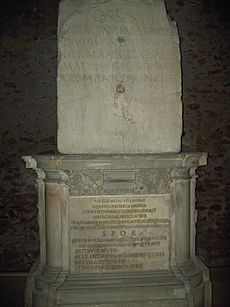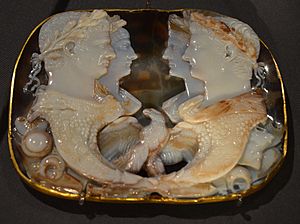Agrippina the Elder facts for kids
Quick facts for kids Agrippina the Elder |
|
|---|---|
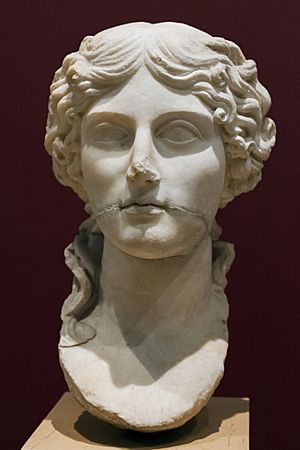
|
|
| Born | c. 14 BC Athens, Greece |
| Died | AD 33 (aged 46) Pandataria |
| Burial | AD 33 Pandataria relocated in March AD 37 to the Mausoleum of Augustus |
| Spouse | Germanicus |
| Issue |
|
| Dynasty | Julio-Claudian |
| Father | Marcus Vipsanius Agrippa |
| Mother | Julia the Elder |
Agrippina the Elder (born around 14 BC – died AD 33) was an important woman in the Julio-Claudian dynasty, a powerful family in ancient Rome. She was the daughter of Marcus Vipsanius Agrippa, a close friend of the first Roman emperor, Augustus. Her mother was Julia the Elder, who was Augustus's own daughter.
Agrippina's brothers, Lucius and Gaius Caesar, were adopted by Augustus to be his heirs. But they both died young. After their deaths, her cousin Germanicus was adopted by Tiberius, Augustus's stepson. This made Germanicus a key figure in the family's plans for who would rule next. Agrippina married Germanicus to strengthen his ties to the imperial family.
Agrippina the Elder often traveled with Germanicus during his military career, even bringing their children along. In AD 14, Germanicus was a general in Gaul (modern-day France). Augustus sent their son Gaius to stay with them. Agrippina liked to dress Gaius in a small soldier's outfit. This is how he got his famous nickname "Caligula," meaning "little soldier's boots."
After three years, they returned to Rome. Germanicus was honored with a special parade called a triumph in AD 17 for his victories. The next year, he was sent to govern provinces in the East. While there, Germanicus had a conflict with the governor of Syria, Gnaeus Calpurnius Piso. Germanicus sadly died of an illness in AD 19.
Agrippina brought her husband's ashes back to Rome. She openly claimed that Germanicus had been murdered. She believed this was done to help Tiberius's son, Drusus the Younger, become the next heir. Agrippina then focused on supporting her own sons, Nero and Drusus Caesar, as future leaders. This put her and her sons in conflict with Lucius Aelius Sejanus, a powerful official. Sejanus began to remove their supporters. This rivalry led to Agrippina and Nero being exiled in AD 29. Agrippina was sent to the island of Pandateria, where she died in AD 33.
Contents
Agrippina's Name and Family
Roman families often shared names. To tell her apart from her granddaughter, Julia Agrippina, historians call her "Agrippina the Elder." Her granddaughter is known as "Agrippina the Younger." Agrippina the Elder usually didn't use her first family name, "Vipsania."
Her Important Family Connections
Agrippina was born in 14 BC. Her parents were Marcus Vipsanius Agrippa and Julia the Elder. She was a very important member of the Julio-Claudian dynasty. This was the ruling family of Rome.
She was the granddaughter of Emperor Augustus. Her mother, Julia, later married Tiberius, who became emperor. This made Tiberius her stepfather. Agrippina was also the sister-in-law of Claudius, who would become emperor later. Her son, Gaius, became the third Roman emperor. Her grandson, Nero, was the last emperor of this dynasty.
Agrippina's father died when she was young. She then grew up in Augustus's home. Her brothers, Gaius and Lucius, were Augustus's chosen heirs. But they both died early. This meant Augustus had to find new heirs. He decided to adopt Tiberius, his stepson. But there was a condition: Tiberius had to adopt Germanicus first. This made Germanicus second in line to the throne. Agrippina then married Germanicus, likely the next year.
Agrippina and Germanicus had nine children. Six of them lived to adulthood. These included Nero Julius Caesar, Drusus Julius Caesar, Caligula, Agrippina the Younger, Julia Drusilla, and Julia Livilla.
Life with Germanicus
Germanicus started his military career in AD 6. Agrippina often traveled with him and their children. Germanicus became a consul, a high-ranking official, in AD 12. The next year, he was given command of Roman forces in Gaul.
In AD 14, her one-year-old son Gaius was sent to join her in Gaul. Agrippina was pregnant at the time. Emperor Augustus sent her a letter with her son. It showed his care for her and her family.
Later that year, Augustus died. Tiberius became the new emperor. While Germanicus was getting his soldiers to promise loyalty to Tiberius, a rebellion started. Agrippina bravely brought out her young son Gaius. He was dressed in a full army outfit, including small soldier's boots. These boots earned him the nickname "Caligula." This act helped calm the soldiers and showed their sympathy for Agrippina and her child.
After the rebellion ended, Germanicus led his troops against Germanic tribes. He fought until AD 16. He was then called back to Rome by Tiberius. Germanicus was very popular for his campaigns. He was given a grand triumph parade in AD 17.
Agrippina as a Widow
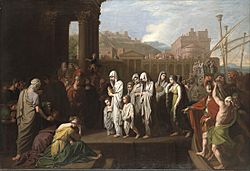
In AD 18, Agrippina traveled to the eastern provinces with her family. Germanicus was sent to govern these areas. On their way to Syria, Agrippina gave birth to her youngest daughter, Julia Livilla, on the island of Lesbos.
Tiberius sent Gnaeus Calpurnius Piso to help Germanicus. Piso was made governor of Syria. But Piso and Germanicus did not get along. Their relationship became very bad. In AD 19, Germanicus ordered Piso to leave the province. Germanicus then fell ill and died on October 10, AD 19, in Antioch. Rumors spread that Piso had poisoned Germanicus on the emperor's orders.
After Germanicus was cremated, Agrippina personally carried his ashes back to Rome. This journey was a time of national sadness. She arrived at the port of Brundisium in southern Italy. Huge crowds of people came to meet her. The emperor even sent a special guard for her. As she passed through towns, people came out to show their respect. Germanicus's ashes were buried in the Mausoleum of Augustus in Rome.
Life After Germanicus
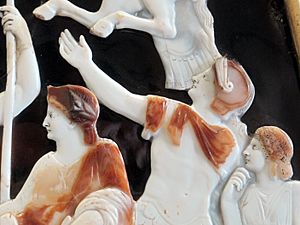
Agrippina's marriage to Germanicus had helped unite the imperial family. After Germanicus died, Agrippina felt she no longer had strong family ties to Emperor Tiberius. She openly said that Germanicus was murdered. She believed this was done to help Tiberius's son, Drusus the Younger, become the next heir. She also worried that Drusus the Younger's twin sons would take her own sons' place in the line of succession.
Around this time, Sejanus, a powerful official, became very influential in Rome. He began to have conflicts with Drusus the Younger. Drusus the Younger died in AD 23. After his death, Agrippina wanted to help her own sons become heirs to Tiberius. Her sons were the logical choice because they were Germanicus's children. Nero, her son, was becoming popular in the Roman Senate.
Sejanus saw Agrippina's sons as a threat to his own power. He began spreading rumors about Agrippina in the imperial court. This led to growing hostility between Sejanus and Agrippina's family. This conflict created two groups among the Roman nobles: one supporting Agrippina and one supporting Sejanus.
Political Challenges
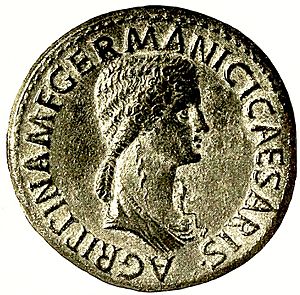
In AD 24, Sejanus had priests and officials add prayers for Nero and Drusus, Agrippina's sons, alongside those for the emperor. Tiberius was not happy about this. He became suspicious of Agrippina and her older sons.
In AD 25, Sejanus asked to marry Livilla, the emperor's niece. This would have made him part of the imperial family. But his request was denied. Agrippina's relationship with Tiberius was also very strained. She even refused to eat at his dinner parties, fearing she might be poisoned. She also asked Tiberius if she could remarry, but he refused this too.
If either Sejanus or Agrippina remarried, it could have complicated the line of succession. Tiberius wanted his own grandchildren and Germanicus's children to be his successors. By refusing Agrippina's request, Tiberius showed he didn't want a new powerful man outside the family to become a stepfather to potential heirs.
In AD 26, Tiberius left Rome and moved to the island of Capri. He left Sejanus in charge of the city. This allowed Sejanus to freely attack his rivals.
Agrippina's Downfall
With Tiberius away, Sejanus and his supporters began to accuse Agrippina and her friends of plotting against the emperor. Many of her friends were charged with "treason." In AD 27, Agrippina was placed under house arrest.
In AD 29, after Tiberius's mother Livia died, Sejanus began his final attack on Agrippina. Tiberius sent a letter to the Senate. It criticized Agrippina for being arrogant and Nero for bad behavior. The Senate then declared Agrippina and Nero public enemies. They were both exiled. Nero was sent to Pontia and died in AD 31. Agrippina was exiled to the island of Pandateria, the same place her mother had been sent.
Some accounts say that while on Pandateria, Agrippina lost an eye after being beaten by a soldier. She stayed on the island until her death in AD 33. It is believed she died from starvation, but it's not clear if she chose to starve herself.
After Her Death

Agrippina's son Drusus was also later exiled. Sejanus remained powerful until his sudden downfall and execution in AD 31. The deaths of Agrippina's older sons meant her youngest son, Caligula, became the next in line. He became emperor when Tiberius died in AD 37.
After becoming emperor, Caligula showed great respect for his mother and brother. He traveled to the islands of Pontia and Pandateria to bring back their remains. It was a difficult journey, but his effort showed his devotion. Their ashes were brought to Rome and placed in the Mausoleum of Augustus, joining Germanicus's ashes. This act reminded people of Agrippina carrying her husband's ashes years earlier. Agrippina's burial urn still exists today.
Agrippina's Personality
Agrippina was a very independent woman, much like her mother. She knew that a woman in ancient Rome could not hold power on her own. So, she focused on helping her children's careers, just like Livia, Augustus's wife, had done.
Historians describe Agrippina as determined and ambitious for her sons. She is also described as "excitable," "arrogant," "proud," and "fierce." However, she was also known for her strong morals and deep love for her husband.
How Historians See Her
Historians say Agrippina had a normal marriage and remained devoted to Germanicus even after his death. The Roman people saw her as "the glory of the country" and a symbol of "the good old times."
Some historians caution that stories about Agrippina's conflicts with Sejanus might be biased. These accounts may have been spread by her supporters or appeared after Sejanus's fall. They are believable, but not entirely certain.
Suetonius's View
The Roman writer Suetonius said that Augustus was proud of Agrippina. He claimed Augustus wrote her a letter praising her intelligence and guiding her education. Augustus, who valued proper speech, also warned Agrippina not to speak "offensively."
Tacitus's View
Tacitus, another Roman historian, wrote about the Julio-Claudian dynasty. He often showed women having a big influence on politics. He portrayed Agrippina as a strong woman who sometimes took on roles usually meant for men. For example, he described her calming the soldiers' rebellion in AD 14. He said she "reversed the natural order of things" by doing something only a general should do.
Agrippina's Portraits
Portraits of Roman women from this time often showed more natural hairstyles than men's. Agrippina's portraits show her with a youthful face, even though she lived to middle age. Her hair is shown as a mass of curls.
Her portraits were made during three main periods:
- When she married Germanicus, as she was the mother of a potential emperor.
- When her son Caligula became emperor in AD 37 and moved her ashes. These portraits show her with idealized, perfect features.
- When Claudius married Agrippina the Younger. These portraits made her look more like her daughter to connect her to Augustus's family line.
The portraits from Tiberius's time are considered the most lifelike.
Cultural Depictions
Agrippina is one of the few Roman women whose story was told in later centuries as an example of good character. Her journey carrying her husband's ashes was a popular subject for painters in the 1700s.
She is also featured in De Mulieribus Claris, a book from the 1300s about famous historical and mythological women. It was the first book in Western literature dedicated only to women's biographies.
Other works featuring Agrippina include:
- Agrippina Mourning over the ashes of Germanicus (1775), an etching by Alexander Runciman.
- The Caesars (1968), a TV series where she was played by Caroline Blakiston.
- I, Claudius (1976), a TV series where she was played by Fiona Walker.
See Also
 In Spanish: Agripina la Mayor para niños
In Spanish: Agripina la Mayor para niños
- Julio-Claudian family tree
- Gaius Silius


